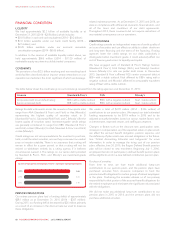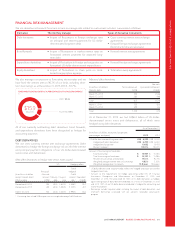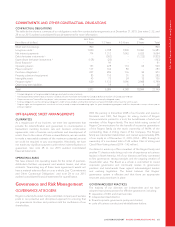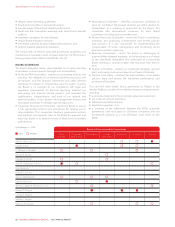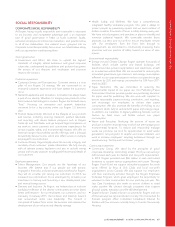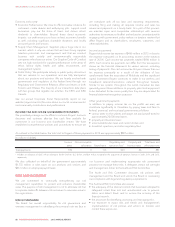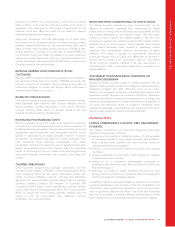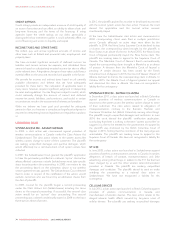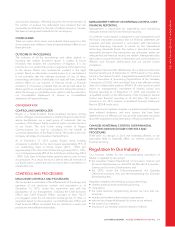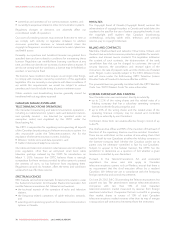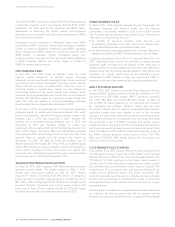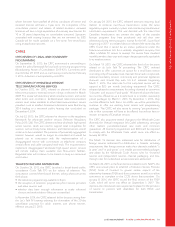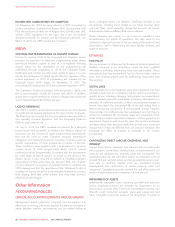Rogers 2015 Annual Report Download - page 72
Download and view the complete annual report
Please find page 72 of the 2015 Rogers annual report below. You can navigate through the pages in the report by either clicking on the pages listed below, or by using the keyword search tool below to find specific information within the annual report.MANAGEMENT’S DISCUSSION AND ANALYSIS
could make it harder for incumbent wireless carriers to acquire
additional spectrum. This includes the completion of our
previously announced arrangement with Videotron. The
legislation regarding foreign ownership of wireless providers
could make it less expensive for foreign wireless carriers to enter
the Canadian wireless market. This could increase the intensity of
competition in the Canadian wireless sector.
In addition, the CRTC Broadcasting Distribution Regulations do not
allow cable operators to obtain exclusive contracts in buildings where
it is technically feasible to install two or more transmission systems.
TECHNOLOGY RISKS
INFORMATION SECURITY RISK
Our industry is vulnerable to cyber risks that are growing in both
frequency and complexity. Rogers, along with our suppliers,
employs systems and network infrastructure that are subject to
cyberattacks, which may include theft of assets, unauthorized
access to sensitive information, or operational disruption. A
significant cyberattack against our – or our suppliers’ – critical
network infrastructure and supporting information systems could
result in service disruptions, litigation, loss of customers, significant
remediation costs, and reputational damage.
Management has placed value on a security program designed to
reinforce the importance of remaining a secure, vigilant, and
resilient organization. Our ongoing success depends on protecting
our sensitive data, including personal information about our
customers and employees. We rely on security awareness training,
policies, procedures, and information technology systems to
protect this information. Rogers continues to monitor this risk,
leveraging external threat intelligence, internal monitoring,
reviewing best practices, and implementing controls as required to
mitigate cybersecurity risks.
External threats to the network are constantly changing and there is
noassurancewewillbeabletoprotectthenetworkfromallfuture
threats. The impact of such attacks may affect service revenue.
IMPACT OF NETWORK FAILURES ON REVENUE AND
CUSTOMER SERVICE
If our networks or key network components fail, it could, in some
circumstances, result in a loss of service for our customers for
certain periods and have an adverse effect on our results and
financial position. We rely on business partners to carry some traffic
for certain customers. If one of these carriers has a service failure, it
might also cause a service interruption for those customers that
would last until we could reroute the traffic to another carrier.
We work to protect our service from the impact of natural disasters
and major weather events such as ice storms, flooding, or
landslides where it is necessary and feasible to do so. There are no
assurances that a future event will not cause service outages. Such
outages may affect service revenue.
DEPENDENCE ON INFORMATION TECHNOLOGY SYSTEMS
Our businesses depend on information technology systems for
day-to-day operations. If we are unable to operate our systems,
make enhancements to accommodate customer growth and new
products and services, or if our systems go down, it could have an
adverse effect on our ability to acquire new subscribers, service
customers, manage subscriber churn, produce accurate and timely
subscriber invoices, generate revenue growth, and manage
operating expenses. This could have an adverse impact on our
results and financial position.
Most of our employees and critical elements of our network
infrastructure and information technology systems are
concentrated in various physical facilities. If we cannot access one
or more of these facilities because of a natural or manmade
disaster or otherwise, our operations may be significantly affected
totheextentthatitmaybedifficultforustorecoverwithouta
significant interruption in service or negative impact to our revenue
or customer base.
UNAUTHORIZED ACCESS TO DIGITAL BOXES OR INTERNET
MODEMS
We use encryption technology developed and supported by our
vendors to protect our cable signals from unauthorized access and
to control access to programming based on subscription
packages. We also use encryption and security technologies to
prevent unauthorized access to our Internet service.
Thereisnoassurancethatwewillbeabletoeffectivelyprevent
unauthorized decoding of television signals or Internet access in
the future. If we are unable to control cable access with our
encryption technology, subscriptions to digital programming,
including premium video-on-demand and subscription video-on-
demand, and Internet service revenue may both decrease, which
could result in a decline in our Cable revenue.
NEW TECHNOLOGY
Our network plans assume the availability of new technology for
both Wireless and Wireline networks. While we work with industry
standards bodies and our vendors to ensure timely delivery of new
technology, there are no assurances these technologies will be
available as and when required.
COMPETING TECHNOLOGIES
Several technologies have affected the way our services are
delivered, including:
• broadband;
• IP-based voice, data and video delivery services;
• increased use of optical fibre technologies to businesses and/or
residences; and
• broadband wireless access and wireless services using a radio
frequency spectrum to which we may have limited or no access.
These technologies may also lead to significantly different cost
structures for users and therefore affect the long-term viability of
some of our current technologies. Some of the new technologies
have allowed competitors to enter our markets with similar
products or services at lower costs. These competitors may also be
larger and have greater access to financial resources than Rogers.
Improvements in the quality of streaming video over the Internet,
coupled with the increasing availability of television shows and
movies online through OTT content providers, which compete for
viewership, are anticipated to increase competition for Canadian
cable television service providers. If advances in technology are
made to any alternative Canadian multi-channel broadcasting
70 ROGERS COMMUNICATIONS INC. 2015 ANNUAL REPORT


